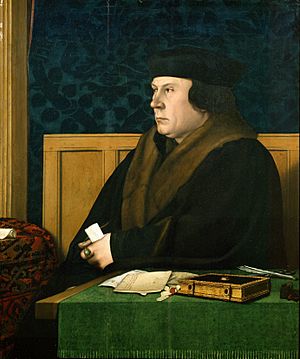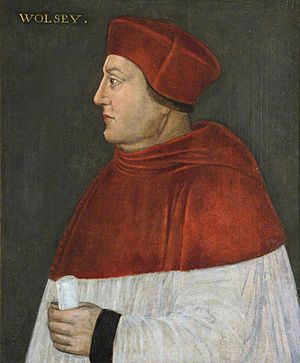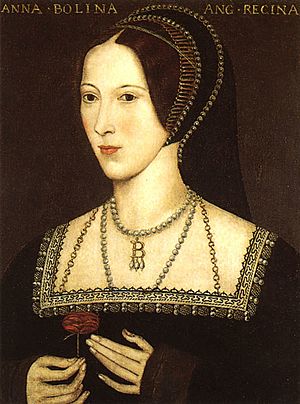Thomas Cromwell facts for kids
Quick facts for kids
Thomas Cromwell
|
|
|---|---|

Portrait of Thomas Cromwell,
Hans Holbein the Younger (1532–1533) |
|
| Lord Great Chamberlain | |
| In office 17 April 1540 – 10 June 1540 |
|
| Monarch | Henry VIII |
| Preceded by | John de Vere, 15th Earl of Oxford |
| Succeeded by | Robert Radcliffe, 1st Earl of Sussex |
| Governor of the Isle of Wight | |
| In office 2 November 1538 – 10 June 1540 |
|
| Monarch | Henry VIII |
| Preceded by | Sir James Worsley |
| Succeeded by | Richard Worsley |
| Lord Privy Seal | |
| In office 2 July 1536 – 10 June 1540 |
|
| Monarch | Henry VIII |
| Preceded by | Thomas Boleyn |
| Succeeded by | William Fitzwilliam |
| Master of the Rolls | |
| In office 8 October 1534 – 10 July 1536 |
|
| Monarch | Henry VIII |
| Preceded by | John Taylor |
| Succeeded by | Christopher Hales |
| Principal Secretary | |
| In office April 1534 – April 1540 |
|
| Monarch | Henry VIII |
| Preceded by | Stephen Gardiner |
| Succeeded by | Thomas Wriothesley |
| Chancellor of the Exchequer | |
| In office 12 April 1533 – 10 June 1540 |
|
| Monarch | Henry VIII |
| Preceded by | John Bourchier |
| Succeeded by | John Baker |
| Personal details | |
| Born | c. 1485 Putney, Surrey |
| Died | 28 July 1540 (aged 54–55) Tower Hill, London |
| Cause of death | Execution by beheading |
| Resting place | Chapel Royal of St. Peter ad Vincula, Tower of London, London, United Kingdom 51°30′31″N 0°04′37″W / 51.508611°N 0.076944°W |
| Spouse | Elizabeth Wyckes |
| Children | Gregory Cromwell, 1st Baron Cromwell Anne Cromwell Grace Cromwell Jane Cromwell |
| Parents | Walter Cromwell, Katherine Meverell |
Thomas Cromwell (born around 1485 – died 28 July 1540) was an important English politician and lawyer. He served as the main advisor to King Henry VIII from 1534 to 1540.
Sadly, the king ordered his execution on 28 July 1540, after Cromwell was accused of serious crimes. Later, King Henry VIII felt very sad about losing him. Many historians believe the king's rule was never quite the same after this event.
Contents
Thomas Cromwell's Early Life
Thomas Cromwell was born in Putney, England, around 1485. His father, Walter Cromwell, was a hardworking man who owned a cloth business, an inn, and a brewery. Thomas's mother, Katherine Meverell, came from a well-known family in Staffordshire.
When he was young, Thomas left his family home. He traveled across Europe, visiting places like France, Italy, and the Low Countries. We don't know many details about what he did during these travels.
Family Life and Children
Around 1515, Thomas Cromwell returned to England and married Elizabeth Wyckes. Elizabeth was a widow whose first husband had been a guard for King Henry VII. Her father was a cloth worker from Putney.
Thomas and Elizabeth had three children together:
- Gregory Cromwell, 1st Baron Cromwell (born around 1520)
- Anne Cromwell (born around 1522)
- Grace Cromwell (born around 1527)
Sadly, Cromwell's wife, Elizabeth, passed away in 1529. His two daughters, Anne and Grace, are also thought to have died around the same time. It's believed they might have died from a serious illness called "sweating sickness." Gregory, his son, lived longer but also died from sweating sickness in 1551.
Rising in Power with the King


By late 1529, Thomas Cromwell became a member of Parliament. He quickly gained the favor of King Henry VIII. The King soon appointed him to his special advisory group, the Privy Council.
The King was very grateful to Cromwell for his hard work. He gave Cromwell land and appointed him to several important government jobs. These jobs showed that the King trusted Cromwell and wanted him to be part of the royal household.
Cromwell held many important positions while working for King Henry VIII, including:
- Chancellor of the Exchequer (in charge of the King's money)
- Principal Secretary (a top advisor to the King)
- Master of the Rolls (a senior judge)
- Lord Privy Seal (another high-ranking government official)
- Vicegerent of the King in Spirituals (a special role overseeing religious matters for the King)
- Governor of the Isle of Wight
Religious Changes in England
Cromwell was a strong supporter of the English Reformation. This was a time when England broke away from the authority of the Pope in Rome. Cromwell helped King Henry VIII end his marriage to Catherine of Aragon. This allowed the King to marry Anne Boleyn.
When the Pope refused to approve the annulment, Parliament declared King Henry VIII the Supreme Head of the Church of England. This meant the King, not the Pope, was in charge of religious matters in England. Cromwell then helped the King make many changes to the church.
Cromwell also worked to change religious practices. He ordered that a complete Bible in English be placed in every church. This was a huge achievement, as it was the first official English version of the Bible. However, some of Cromwell's changes led to protests and uprisings, like the Pilgrimage of Grace.
Over time, King Henry VIII became less happy with some of Cromwell's religious changes. The King wanted to keep some traditional religious beliefs.
Cromwell's Downfall and Execution
Cromwell's influence began to weaken, especially after he arranged the King's marriage to Anne of Cleves in January 1540. The King was very disappointed when he met Anne, as he felt her portrait had made her seem more beautiful. Some historians think the artist, Hans Holbein the Younger, might have made Anne look too good in the painting.
On 10 June 1540, Cromwell was arrested during a meeting. He was accused of various serious crimes against the King. Cromwell was taken to the Tower of London and imprisoned.
A special law, called a Bill of Attainder, was passed against him. This law listed many accusations, including supporting certain religious groups and acting for his own benefit. All of Cromwell's titles and property were taken away.
The King delayed Cromwell's execution for a short time. He hoped Cromwell might help with the annulment of his marriage to Anne of Cleves. Anne agreed to end the marriage peacefully. Cromwell, hoping for mercy, wrote a letter to the King supporting the annulment. He ended his letter by begging for mercy.
Despite his plea, Thomas Cromwell was executed on Tower Hill on 28 July 1540. On the same day, King Henry VIII married Catherine Howard. On the scaffold, Cromwell made a speech, saying he died in the traditional Christian faith. This was likely to protect his family.
Cromwell's Impact on England
During his time in power, Thomas Cromwell was very skilled at managing the King's money and strengthening royal authority. He created new government departments to handle the wealth gained from closing down monasteries.
He also helped the King gain more control in northern England and introduced Protestant ideas in Ireland. Cromwell was also key in passing the Laws in Wales Acts 1535 and 1542. These laws helped bring stability to Wales and made sure the King's authority was accepted there. He also introduced important social and economic changes in England, such as helping the poor.
Holbein's Portraits of Cromwell
Thomas Cromwell was a supporter of the famous artist Hans Holbein the Younger. Holbein painted portraits of many important people of that time, including Cromwell.
In the Frick Collection in New York, there are two portraits by Holbein that hang facing each other. One is of Thomas Cromwell, and the other is of Thomas More. More was a political and religious opponent of Cromwell who was also executed.
Images for kids
-
Cromwell's coat of arms as Earl of Essex.
See also
 In Spanish: Thomas Cromwell para niños
In Spanish: Thomas Cromwell para niños




